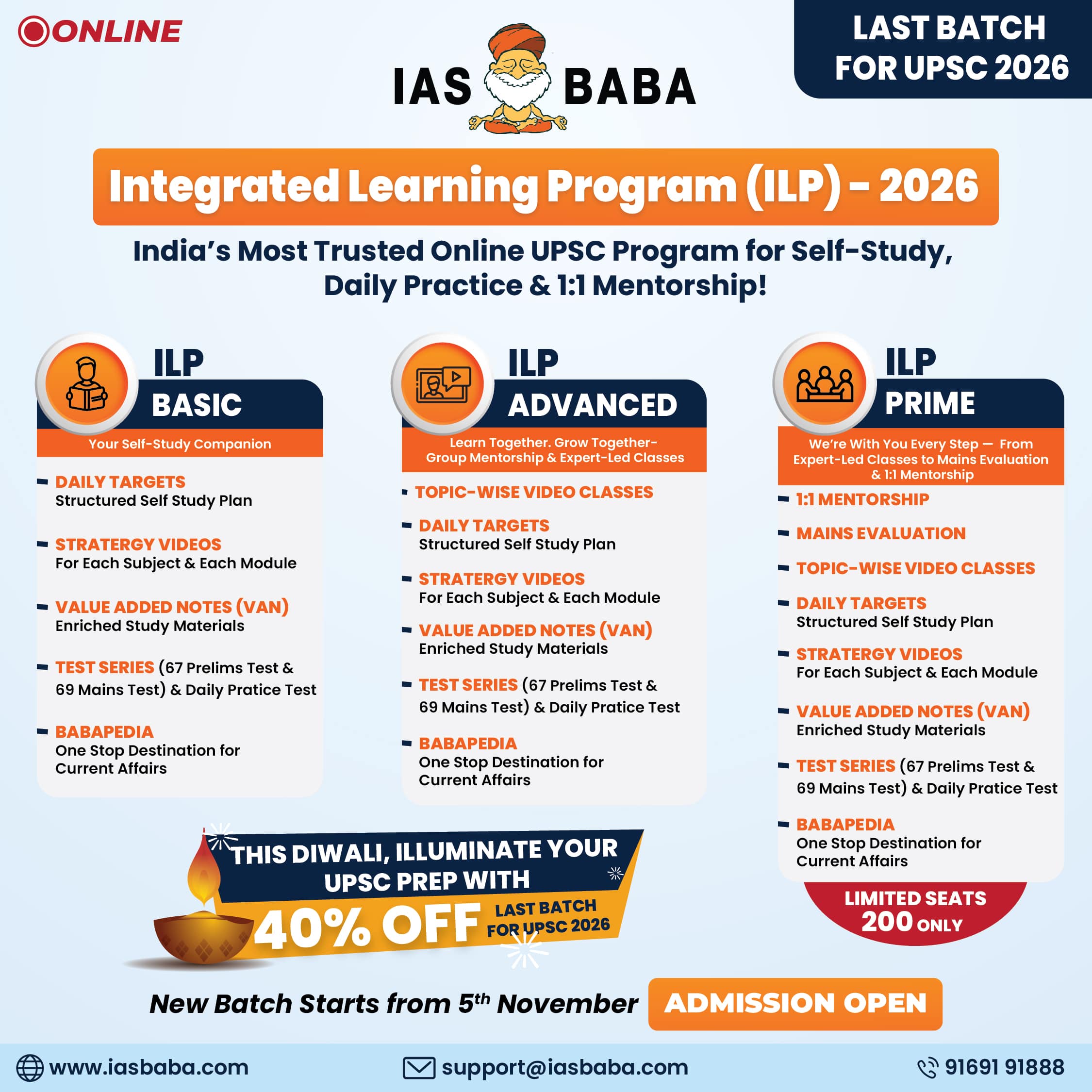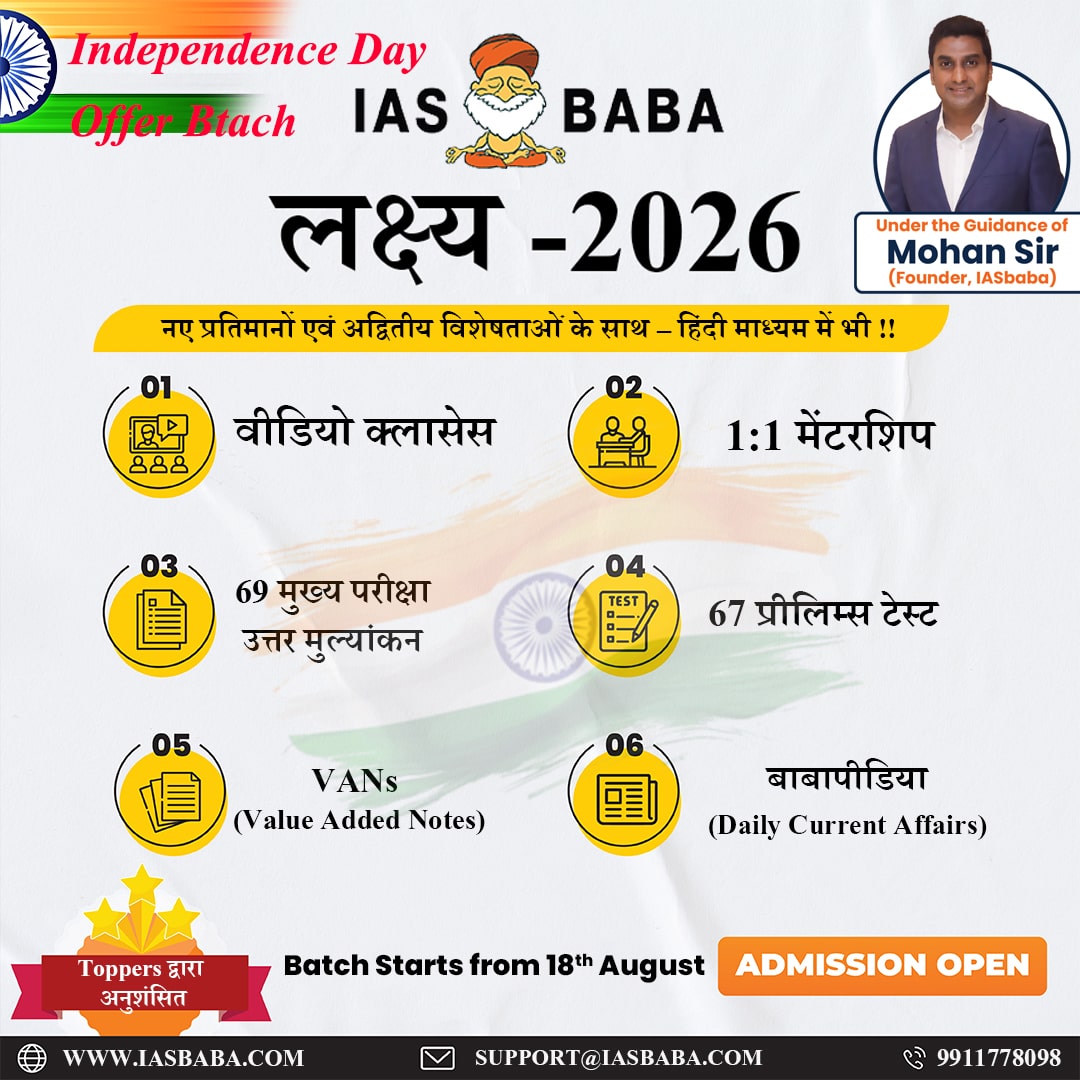IASbaba Daily Prelims Quiz
For Previous Daily Quiz (ARCHIVES) – CLICK HERE
The Current Affairs questions are based on sources like ‘The Hindu’, ‘Indian Express’ and ‘PIB’, which are very important sources for UPSC Prelims Exam. The questions are focused on both the concepts and facts. The topics covered here are generally different from what is being covered under ‘Daily Current Affairs/Daily News Analysis (DNA) and Daily Static Quiz’ to avoid duplication. The questions would be published from Monday to Saturday before 2 PM. One should not spend more than 10 minutes on this initiative.
Gear up and Make the Best Use of this initiative.
Do remember that, “the difference between Ordinary and EXTRA-Ordinary is PRACTICE!!”
Important Note:
- Don’t forget to post your marks in the comment section. Also, let us know if you enjoyed today’s test 🙂
- After completing the 5 questions, click on ‘View Questions’ to check your score, time taken, and solutions.
Test-summary
0 of 5 questions completed
Questions:
- 1
- 2
- 3
- 4
- 5
Information
To view Solutions, follow these instructions:
- Click on – ‘Start Test’ button
- Solve Questions
- Click on ‘Test Summary’ button
- Click on ‘Finish Test’ button
- Now click on ‘View Questions’ button – here you will see solutions and links.
You have already completed the test before. Hence you can not start it again.
Test is loading...
You must sign in or sign up to start the test.
You have to finish following test, to start this test:
Results
0 of 5 questions answered correctly
Your time:
Time has elapsed
You have scored 0 points out of 0 points, (0)
| Average score |
|
| Your score |
|
Categories
- Not categorized 0%
| Pos. | Name | Entered on | Points | Result |
|---|---|---|---|---|
| Table is loading | ||||
| No data available | ||||
- 1
- 2
- 3
- 4
- 5
- Answered
- Review
-
Question 1 of 5
1. Question
Consider the following statements regarding the Insolvency and Bankruptcy Code (IBC), 2016:
- IBC shifted control from creditors to debtors during insolvency resolution.
- It mandates a time-bound insolvency resolution process with a 330-day deadline.
- It applies only to companies and excludes individuals and partnership firms.
Which of the above statements is/are correct?
Correct
Answer: A
Explanation:
- Statement 1 is incorrect – IBC shifted control from debtors to creditors, not the other way around.
- Statement 2 is correct – IBC provides a 330-day limit for resolving insolvency.
Statement 3 is incorrect – IBC applies to individuals, partnership firms, and companies.
Incorrect
Answer: A
Explanation:
- Statement 1 is incorrect – IBC shifted control from debtors to creditors, not the other way around.
- Statement 2 is correct – IBC provides a 330-day limit for resolving insolvency.
Statement 3 is incorrect – IBC applies to individuals, partnership firms, and companies.
-
Question 2 of 5
2. Question
Consider the following pairs regarding monetary tools and their effects:
Monetary Tool Effect 1. Repo Rate Cut Reduces borrowing costs 2. CRR Cut Increases liquidity with commercial banks 3. Reverse Repo Rate Increases credit availability to public Which of the above pairs are correctly matched?
Correct
Answer: A
Explanation:
Pair 1: Repo Rate Cut → Reduces borrowing costs
- Repo rate is the rate at which the RBI lends money to commercial banks.
- When the repo rate is reduced:
- Banks can borrow funds from the RBI at a lower cost.
- This leads to reduced lending rates for consumers and businesses.
- Ultimately, it lowers EMIs for loans and stimulates credit growth.
Correctly matched.
Pair 2: CRR Cut → Increases liquidity with commercial banks
- CRR (Cash Reserve Ratio) is the percentage of a bank’s total deposits that must be kept with the RBI in cash and cannot be lent.
- When the CRR is reduced:
- Banks need to keep less money idle with the RBI.
- This frees up more money that can be used for lending and investment.
- Thus, it increases liquidity in the banking system.
Correctly matched.
Pair 3: Reverse Repo Rate → Increases credit availability to public
- Reverse repo rate is the rate at which the RBI borrows money from commercial banks.
- If the reverse repo rate is increased, banks find it more attractive to park their funds with the RBI instead of lending.
- This results in reduced credit availability to the public.
- If the reverse repo rate is decreased, banks prefer lending more to the public, but that is an indirect effect.
Incorrectly matched – Reverse repo rate does not directly increase credit availability.
Final Answer: A. 1 and 2 only
Incorrect
Answer: A
Explanation:
Pair 1: Repo Rate Cut → Reduces borrowing costs
- Repo rate is the rate at which the RBI lends money to commercial banks.
- When the repo rate is reduced:
- Banks can borrow funds from the RBI at a lower cost.
- This leads to reduced lending rates for consumers and businesses.
- Ultimately, it lowers EMIs for loans and stimulates credit growth.
Correctly matched.
Pair 2: CRR Cut → Increases liquidity with commercial banks
- CRR (Cash Reserve Ratio) is the percentage of a bank’s total deposits that must be kept with the RBI in cash and cannot be lent.
- When the CRR is reduced:
- Banks need to keep less money idle with the RBI.
- This frees up more money that can be used for lending and investment.
- Thus, it increases liquidity in the banking system.
Correctly matched.
Pair 3: Reverse Repo Rate → Increases credit availability to public
- Reverse repo rate is the rate at which the RBI borrows money from commercial banks.
- If the reverse repo rate is increased, banks find it more attractive to park their funds with the RBI instead of lending.
- This results in reduced credit availability to the public.
- If the reverse repo rate is decreased, banks prefer lending more to the public, but that is an indirect effect.
Incorrectly matched – Reverse repo rate does not directly increase credit availability.
Final Answer: A. 1 and 2 only
-
Question 3 of 5
3. Question
With reference to the Group of Seven (G7), consider the following statements:
- The G7 was established in response to the oil crisis and global recession of the 1970s.
- The European Union is a full member of the G7.
- G7 decisions are legally binding on all its members.
- Russia was permanently expelled from the group in 2014.
Which of the statements given above is/are correct?
Correct
Answer: B. 1 and 4 only
Explanation:
- Statement 1 is correct – G7 emerged in 1975 in response to the oil shock and economic turmoil.
- Statement 2 is incorrect – EU participates, but is not a full member.
- Statement 3 is incorrect – G7 is an informal forum; decisions are not legally binding.
Statement 4 is correct – Russia was suspended in 2014 after Crimea; not readmitted.
Incorrect
Answer: B. 1 and 4 only
Explanation:
- Statement 1 is correct – G7 emerged in 1975 in response to the oil shock and economic turmoil.
- Statement 2 is incorrect – EU participates, but is not a full member.
- Statement 3 is incorrect – G7 is an informal forum; decisions are not legally binding.
Statement 4 is correct – Russia was suspended in 2014 after Crimea; not readmitted.
-
Question 4 of 5
4. Question
In which of the following ways do recent archaeological discoveries contribute to the understanding of Indian history?
- Provide evidence of socio-economic systems like taxation and land grants
- Help in dating dynasties and rulers more accurately
- Confirm mythological stories from religious texts
- Reveal lost architectural and cultural traditions
Select the correct answer using the code below:
Correct
Answer: A. 1, 2 and 4 only
Explanation:
While archaeology can offer cultural insights and evidence of economic systems and architecture, mythological stories are not usually confirmed through archaeological records in a historical sense.Incorrect
Answer: A. 1, 2 and 4 only
Explanation:
While archaeology can offer cultural insights and evidence of economic systems and architecture, mythological stories are not usually confirmed through archaeological records in a historical sense. -
Question 5 of 5
5. Question
Consider the following statements about Anti-Submarine Warfare (ASW) warships:
- ASW warships primarily rely on sonar and torpedoes to detect and neutralize underwater threats.
- Their operational effectiveness is limited in shallow coastal waters due to acoustic challenges.
- ASW vessels also contribute to maritime domain awareness and coastal security.
Which of the statements given above is/are correct?
Correct
Answer: B) 1 and 3 only
Explanation:
- Statement 1 is correct: ASW warships use sonar systems (active and passive) to detect underwater objects like submarines, and torpedoes or depth charges to neutralize them. These are the primary tools in ASW operations.
- Statement 2 is incorrect: While shallow coastal waters present acoustic challenges—due to factors like high ambient noise, irregular seabed, and temperature gradients—specialized shallow water ASW vessels (like INS Arnala) are designed to operate effectively in these environments by using advanced sonar and stealth technologies. Thus, their effectiveness is not inherently limited but requires adapted capabilities.
- Statement 3 is correct: ASW ships also perform broader roles, including maritime domain awareness—monitoring and securing maritime zones, preventing infiltration, and supporting coastal security. Their sensor suites and patrol duties contribute beyond pure ASW.
Incorrect
Answer: B) 1 and 3 only
Explanation:
- Statement 1 is correct: ASW warships use sonar systems (active and passive) to detect underwater objects like submarines, and torpedoes or depth charges to neutralize them. These are the primary tools in ASW operations.
- Statement 2 is incorrect: While shallow coastal waters present acoustic challenges—due to factors like high ambient noise, irregular seabed, and temperature gradients—specialized shallow water ASW vessels (like INS Arnala) are designed to operate effectively in these environments by using advanced sonar and stealth technologies. Thus, their effectiveness is not inherently limited but requires adapted capabilities.
- Statement 3 is correct: ASW ships also perform broader roles, including maritime domain awareness—monitoring and securing maritime zones, preventing infiltration, and supporting coastal security. Their sensor suites and patrol duties contribute beyond pure ASW.
- Current Affairs Quiz, IAS Daily Current Affairs Quiz, IAS UPSC Current Affairs Quiz, IAS UPSC Prelims Quiz, IASbaba's Current Affairs Prelims Quiz, IASbaba's Daily Quiz, IASbaba's UPSC Quiz, Prelims Current Affairs Quiz, UPSC Current Affairs Quiz, UPSC Current Affairs Quiz IASbaba, UPSC Daily Current Affair Quiz, UPSC IAS Daily Quiz













